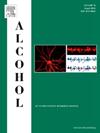The impact of alcohol addiction on the quality of life, mental condition, clinical condition and nutritional status of patients with head and neck cancer
IF 2.9
4区 医学
Q3 PHARMACOLOGY & PHARMACY
引用次数: 0
Abstract
Introduction
Head and neck squamous cell carcinoma (HNSCC) is the sixth most common cancer worldwide, with over 880,000 new cases reported worldwide each year. Tobacco smoking and alcohol drinking are the main risk factors for HNSCC, accounting for 30 % of HNSCC cases worldwide. Alcohol is a particularly important risk factor not only for HNSCC and was recognized in 1988 by the International Agency for Research on Cancer (IARC) as a very important risk factor for the incidence of oral cavity, oropharyngeal, hypopharyngeal and laryngeal cancers, and was classified as group 1 cancer risk factors. The aim of the study was to assess the impact of alcohol on the quality of life, mental state, clinical state and nutritional status in patients with HNSCC.
Material and method
The single-center, prospective study included a group of 123 patients aged 42 to 89, treated for laryngeal cancer, pharyngeal cancer and cancer of unknown primary site HNSCC. Socio-demographic data and the presence of risk factors were assessed in each patient. The performance status of the patients was assessed using the Eastern Cooperative Oncology Group (ECOG) scale. The nutritional status of patients was assessed via a Body Mass Index (BMI) assessment and Mini Nutritional Assessment Short FORM (MNA-SF). Each patient was also assessed using the Nutrition Risk Screening 2002 (NRS2002). The level of depression and anxiety was assessed using the Hospital Anxiety and Depression Scale (HADS). Patients were also assessed for sleep problems using the Insomnia Severity Index. Quality of life was assessed using the Polish version of the European Organization for Research and Treatment of Cancer Quality of Life Questionnaire for Head and Neck Cancer 35 (EORTC QLQ-H&N35). In each patient, the results of laboratory tests were also analyzed - morphology, nutritional parameters - total protein, total cholesterol and CRP protein level.
Results
Patients who regularly drank alcohol more often suffered from throat cancer (91.2 %) and larynx cancer (59.2 %), while CUP was more often diagnosed in patients without a history of regular alcohol consumption. Patients who drank alcohol were diagnosed at a significantly higher stage compared to the group of non-drinkers. In the study group of patients regularly drinking alcohol with diagnosed HSCC, a significantly worse clinical condition, risk of malnutrition or malnutrition was demonstrated compared to patients with diagnosed HNSCC who did not drink alcohol. In laboratory tests, patients drinking alcohol had a lower hemoglobin level before treatment (11.7 vs 12.8 g/dl, p < 0.001), a higher leukocyte level (10.3 vs 7.5 × 10 9/l, p < 0.001), a lower total protein level (6.3 vs 6.8 g/dl, p < 0.001), a higher mean CRP level (8.0 vs 5.0 mg/l) and a lower total cholesterol level (134 vs 187 mg/dl, p < 0.001). Those who drank alcohol more often had significantly worse mental state and sleep problems in HADS and ISI surveys compared to those who did not drink alcohol. In the results of the EORT QLQ-H&N35 survey, patients who drank alcohol had worse results in questions about pain sensation, swallowing, sticky saliva, felt ill, speech, social eating and social contact.
Conclusions
Alcohol is a significant risk factor for HNSCC, usually associated by patients with smoking. It significantly affects the deterioration of the clinical condition and nutritional status of patients. It is a significant factor reducing the quality of life and worsening the mental state of patients with HNSCC. It is necessary to implement comprehensive care for patients abusing alcohol, along with education and promotion of cessation of alcohol consumption together with smoking. It is necessary to raise social awareness from the youngest age, and implement environmental and educational preventive measures with political support. Strengthening the view of alcohol carcinogenicity can significantly reduce morbidity and improve treatment outcomes in patients with HNSCC.
酒精成瘾对头颈癌患者生活质量、精神状况、临床状况及营养状况的影响
头颈部鳞状细胞癌(HNSCC)是全球第六大常见癌症,每年全球报告的新病例超过88万例。吸烟和饮酒是HNSCC的主要危险因素,占全球HNSCC病例的30%。酒精不仅是HNSCC的一个特别重要的危险因素,而且在1988年被国际癌症研究机构(IARC)确认为口腔癌、口咽癌、下咽癌和喉癌发病率的一个非常重要的危险因素,并被列为第1组癌症危险因素。本研究的目的是评估酒精对HNSCC患者生活质量、精神状态、临床状态和营养状况的影响。材料与方法本研究为单中心前瞻性研究,纳入123例42 - 89岁的喉癌、咽癌和原发部位未知的HNSCC患者。评估每位患者的社会人口统计数据和危险因素的存在。采用东部肿瘤合作组(ECOG)量表评估患者的表现状态。通过身体质量指数(BMI)评估和迷你营养评估简表(MNA-SF)评估患者的营养状况。每位患者还使用2002年营养风险筛查(NRS2002)进行评估。采用医院焦虑抑郁量表(HADS)评估抑郁和焦虑水平。研究人员还使用失眠症严重程度指数来评估患者的睡眠问题。生活质量采用波兰版欧洲癌症研究和治疗组织头颈癌生活质量问卷35 (EORTC QLQ-H&N35)进行评估。对每位患者的实验室检查结果也进行了分析——形态学、营养参数——总蛋白、总胆固醇和CRP蛋白水平。结果经常饮酒的患者患咽喉癌(91.2%)和喉癌(59.2%)较多,而无经常饮酒史的患者多患CUP。与不饮酒的患者相比,饮酒患者的诊断阶段明显更高。在诊断为hsc的定期饮酒患者的研究组中,与未饮酒的诊断为HNSCC的患者相比,临床状况、营养不良或营养不良的风险明显更差。在实验室测试中,饮酒患者治疗前血红蛋白水平较低(11.7 vs 12.8 g/dl, p < 0.001),白细胞水平较高(10.3 vs 7.5 × 109 /l, p < 0.001),总蛋白水平较低(6.3 vs 6.8 g/dl, p < 0.001),平均CRP水平较高(8.0 vs 5.0 mg/l),总胆固醇水平较低(134 vs 187 mg/dl, p < 0.001)。在HADS和ISI的调查中,与不喝酒的人相比,经常喝酒的人有更严重的精神状态和睡眠问题。在EORT qq - h&;N35调查的结果中,饮酒的患者在疼痛感、吞咽、唾液粘稠、感觉不适、语言、社交饮食和社交接触等问题上的表现更差。结论酒精是HNSCC的重要危险因素,通常与吸烟相关。显著影响患者临床状况和营养状况的恶化。是降低HNSCC患者生活质量、恶化患者精神状态的重要因素。有必要对酗酒患者实施综合护理,同时进行戒烟和戒酒的教育和宣传。必须从最年轻的年龄开始提高社会意识,并在政治支持下实施环境和教育预防措施。加强对酒精致癌性的认识可以显著降低HNSCC患者的发病率,改善治疗效果。
本文章由计算机程序翻译,如有差异,请以英文原文为准。
求助全文
约1分钟内获得全文
求助全文
来源期刊

Alcohol
医学-毒理学
CiteScore
4.60
自引率
4.30%
发文量
74
审稿时长
15.6 weeks
期刊介绍:
Alcohol is an international, peer-reviewed journal that is devoted to publishing multi-disciplinary biomedical research on all aspects of the actions or effects of alcohol on the nervous system or on other organ systems. Emphasis is given to studies into the causes and consequences of alcohol abuse and alcoholism, and biomedical aspects of diagnosis, etiology, treatment or prevention of alcohol-related health effects.
Intended for both research scientists and practicing clinicians, the journal publishes original research on the neurobiological, neurobehavioral, and pathophysiological processes associated with alcohol drinking, alcohol abuse, alcohol-seeking behavior, tolerance, dependence, withdrawal, protracted abstinence, and relapse. In addition, the journal reports studies on the effects alcohol on brain mechanisms of neuroplasticity over the life span, biological factors associated with adolescent alcohol abuse, pharmacotherapeutic strategies in the treatment of alcoholism, biological and biochemical markers of alcohol abuse and alcoholism, pathological effects of uncontrolled drinking, biomedical and molecular factors in the effects on liver, immune system, and other organ systems, and biomedical aspects of fetal alcohol spectrum disorder including mechanisms of damage, diagnosis and early detection, treatment, and prevention. Articles are published from all levels of biomedical inquiry, including the following: molecular and cellular studies of alcohol''s actions in vitro and in vivo; animal model studies of genetic, pharmacological, behavioral, developmental or pathophysiological aspects of alcohol; human studies of genetic, behavioral, cognitive, neuroimaging, or pathological aspects of alcohol drinking; clinical studies of diagnosis (including dual diagnosis), treatment, prevention, and epidemiology. The journal will publish 9 issues per year; the accepted abbreviation for Alcohol for bibliographic citation is Alcohol.
 求助内容:
求助内容: 应助结果提醒方式:
应助结果提醒方式:


